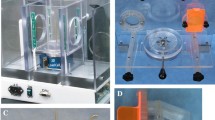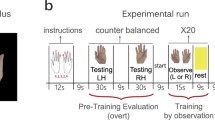Abstract
Intermanual transfer for a skilled motor task was studied in two patients with total callosal agenesis, and one with an acquired partial callosal lesion and clinical evidence for disturbed transfer of motor signals. Patients had to draw meaningless figures with one upper extremity (original learning, OL) and to reproduce their mirror-reversals thereafter with the other side (transfer learning, TL). Both directions of intermanual transfer were tested in two conditions, that is, between either proximal or distal muscle groups. Transfer was evaluated by comparing OL and TL performance at the same effector. The main variable of interest was movement time during the first eight trials of OL and TL. All three patients displayed a significant benefit for transfer from the dominant to the non-dominant hand but not vice versa during proximal motor activity. When compared with the performance of healthy subjects tested in almost identical conditions in a previously reported study, the proximal transfer behavior was found to be similar for all patients and the normal group. Although patients exhibited no significant benefit for distal transfer, their non-dominant-to-dominant distal transfer was above the normal range. The similar transfer pattern of the patients and healthy subjects when using proximal musculature suggests that proximal transfer may be subserved by identical extracallosal pathways, most probably by the ipsilaterally descending motor systems. Since non-dominant-to-dominant distal transfer was found to be disadvantageous in healthy subjects, the patients' relative superiority in this condition may reflect missing callosal influences of an inhibitory nature.
Similar content being viewed by others
References
Bortz J (1989) Statistik für Sozialwissenschafter. Springer, Berlin Heidelberg New York, p 322
Brinkman J, Kuypers HGJM (1973) Cerebral control of contralateral and ipsilateral arm, hand and finger movements in the split-brain rhesus monkey. Brain 96: 653–674
Bryden MP (1977) Measuring handedness with questionnaires. Neuropsychologia 15: 617–624
Colebatch JG, Gandevia SC (1989) The distribution of muscular weakness in upper motor neuron lesions affecting the arm. Brain 112: 749–763
Cook ND (1986) The brain code. Mechanisms of information transfer and the role of the corpus callosum. Methuen, New York
Gazzaniga MS, Bogen JE, Sperry RW (1967) Dyspraxia following division of the cerebral commissures. Arch Neurol 16: 606–612
Gould HJ, Cusick CG, Pons TP, Kaas JH (1986) The relationship of corpus callosum connections to electrical stimulation maps of motor, supplementary motor, and the frontal eye fields in owl monkeys. J Comp Neurol 247: 297–325
Harrison DW (1991) Concurrent verbal interference of right and left proximal and distal upper extremity tapping. Acta Psychol 76: 121–132
Howell DC (1992) Statistical methods for psychology. Duxbury Press, Belmont, Calif, p 308
Iacoboni M, Zaidel E (1995) Channels of the corpus callosum: evidence from simple reaction times to lateralized flashes in the normal and split brain. Brain 118: 779–788
Lassonde M, Sauerwein H, Geoffroy G, Décarie M (1986) Effects of early and late transection of the corpus callosum in children. Brain 109: 953–967
Lassonde M, Sauerwein H, McCabe N, Laurencelle L, Geoffroy G (1988) Extent and limits of cerebral adjustment to early section or congenital absence of the corpus callosum. Behav Brain Res 30: 165–181
Levin HS, Mattson AJ, Levander M, Lindquist CEH, Simard JM, Guinto FC, Lilly MA, Eisenberg HM (1993) Effects of transcallosal surgery in interhemispheric transfer of information. Surg Neurol 40: 65–74
Luria AR (1980) Higher cortical functions in man, 2nd edn. Basic Books, New York, p 421
Mack L, Rothi LJG, Heilman KM (1993) Hemispheric specialization for handwriting in right handers. Brain Cogn 21: 80–86
Marzi CA, Bisiacchi P, Nicoletti R (1991) Is interhemispheric transfer of visuomotor information asymmetric? Evidence from a meta-analysis. Neuropsychologia 29: 1163–1177
Mayer E, Hauert C-A, Pellizzer G, Stucchi N (1991) Coordinations bimanuelles dans un cas de dysconnexion calleuse. Rev Neuropsychol 1: 434–435
Meyer B-U, Röricht S, Gräfin von Einsiedel H, Kruggel F, Weindl A (1995) Inhibitory and excitatory interhemispheric transfers between motor cortical areas in normal humans and patients with abnormalities of the corpus callosum. Brain 118: 429–440
Moscovitch M (1977) The development of lateralization of language functions and its relation to cognitive and linguistic development: a review and some theoretical speculations. In: Segalowitz SJ, Gruber FA (eds) Language development and neurological theory. Academic Press, New York, pp 193–211
Nakamura K, Naito H, Kurosaki T, tamura Y (1971) Effect of polarizing currents on transcallosal postsynaptic potentials of cat pyramidal tract cells. Brain Res 35: 547–550
Pandya DN, Vignolo LA (1971) Intra- and interhemispheric projections of the precentral, premotor and arcuate areas in the rhesus monkey. Brain Res 26: 217–233
Parlow SE, Kinsbourne M (1989) Asymmetrical transfer of training between hands: implications for interhemispheric communication in normal brain. Brain Cogn 11: 98–113
Peters M, Murphy K (1992) Cluster analysis reveals at least three, and possibly five distinct handedness groups. Neuropsychologia 30: 373–380
Poffenberger AT (1912) Reaction time to retinal stimulation with special reference to the time lost in conduction through nervous centres. Arch Psychol 23: 1–73
Steenhuis RE, Bryden MP (1989) Different dimensions of hand preference that relate to skilled and unskilled activities. Cortex 25: 289–304
Thut G, Cook ND, Regard M, Leenders KL, Halsband U, Landis T (1996) Intermanual transfer of proximal and distal motor engrams in humans. Exp Brain Res 108: 321–327
Author information
Authors and Affiliations
Rights and permissions
About this article
Cite this article
Thut, G., Halsband, U., Regard, M. et al. What is the role of the corpus callosum in intermanual transfer of motor skills? A study of three cases with callosal pathology. Exp Brain Res 113, 365–370 (1997). https://doi.org/10.1007/BF02450335
Received:
Accepted:
Issue Date:
DOI: https://doi.org/10.1007/BF02450335




